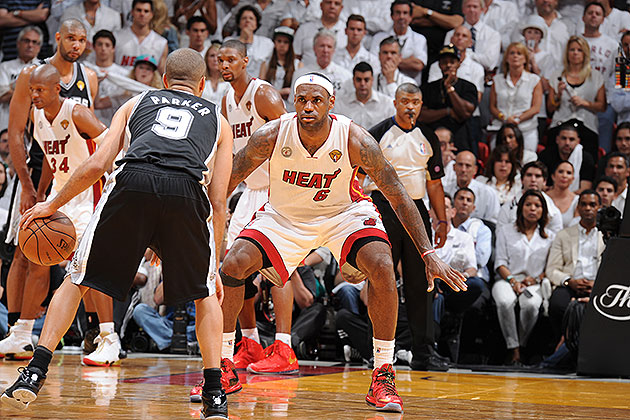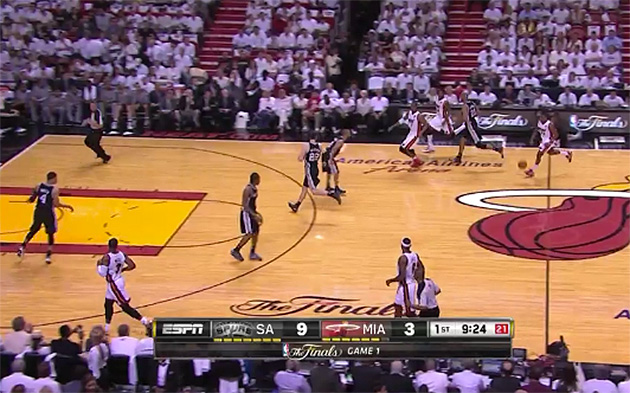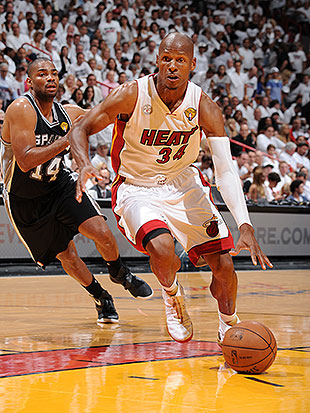
After a thrilling start to the NBA Finals that saw the San Antonio Spurs take a 1-0 lead over the Miami Heat thanks to the order-within-chaos brilliance of Tony Parker, both teams, their fans and folks like me have had two full days to digest what happened and think about what comes next. We know Dwyane Wade says Game 2 is a "must-win" for the Heat with three games in San Antonio looming. We know all eyes will be on Chris Bosh every time he tees up a shot, on LeBron James every time he chooses to pass rather than shoot, and on both James and Parker whenever they get matched up one-on-one.
But in addition to those subplots — plus the Spurs' ball security and the way each team shoots from the corners, two key pieces I wrote about Friday — what else should we be keeping an eye on as we head into Game 2? Here are three more questions to consider as we get set for tipoff and pray for another four quarters like the ones we got Thursday:
• Can San Antonio keep getting bodies behind the ball to prevent Miami from getting out in transition?
Among other things, the Heat want more of this in Game 2:
According to Synergy Sports Technology's play-charting data, the Heat scored 12 points on 10 transition possessions in Game 1, which was right around their league-leading season average for transition point-production (1.22 points per possession). They went 5 for 8 from the floor, with two open trail 3-pointers (one by Mike Miller, another by Shane Battier) among the three misses.
"Both teams understand that you have to try to get some easy ones," Heat head coach Erik Spoelstra said Saturday. "[Getting] in the open court would certainly help."
The problem is that the Spurs' rebounding philosophy tends to de-emphasize crashing the offensive boards in favor of balancing the floor by busting it back on defense, which ABC's cameras caught San Antonio head coach Gregg Popovich emphasizing during a second-quarter timeout in Game 1
“We’re going to miss some shots,” Popovich said. “I don’t care. But I care about the transition, all right?”
Time and again, San Antonio raced back to prevent early Miami offense, sometimes resulting in strong-safety-style shutdowns like this Tim Duncan erasure of a first-quarter Chris Bosh leak-out:
More often, though, the Spurs' strategic retreat resulted in stuff like this first-quarter Heat possession that followed a missed Tiago Splitter layup:

All five Spurs are behind the ball as Mario Chalmers crosses the timeline, including Duncan, who had been boxed out under the basket when Udonis Haslem grabbed the rebound of Splitter's miss.
Miami wound up scoring here on a Chalmers 3 from the left corner, but that only came after a double screen for Chalmers on the right wing; a baseline drive by Wade shut off by Danny Green before Wade could gain the paint; a kick-out to Chris Bosh, who wanted to drive but was deterred by a Splitter closeout; a second high screen from Bosh for Wade that was stalled above the free-throw line; and a jump-pass to the corner for Chalmers, whose 3 dropped through with eight seconds left on the shot clock.
While Popovich probably wasn't happy that the Heat got three out of that possession, he surely prefers Miami having to work through multiple actions and counters against San Antonio's stellar half-court defense than getting right to the rim. That San Antonio effort was remarkable consistent throughout Game 1, and especially after halftime — the Heat had no fast-break points in the second half and only two real transition possessions, thanks in large part to how hard the Spurs worked to get back.
Of course, it's easier to get bodies behind the ball when you can see where the ball is and aren't surprised by what's coming, which is why the Spurs' remarkable Game 1 ball control — just four turnovers in 48 minutes — was so critical in containing the Heat's transition game.
"If we can deflect a few of those passes, give our playmakers an opportunity to get in those passing lanes and get a few steals [...] it's always easier to get points on the break instead of facing the half-court D," Haslem said.
"I expect them, of course, to play an even better game, to be more aggressive, try to make us play uncomfortable, force turnovers and push it," Spurs guard Manu Ginobili said. "They're going to try to use their athletic abilities to get to the paint, to score, to get the fans involved. And we have to be calm, we have to move the ball well, and don't let them get us on our heels, basically."
In other words, the Spurs must keep being themselves by not beating themselves, and Miami must return to being themselves by making it impossible for San Antonio to do so.
• Will Spoelstra look to get James on the floor with Miller and Ray Allen more often?
 At this point, we know that Miller's moved well ahead of Shane Battier in the Heat rotation, and for good reason. Miami's outscoring its opposition by about 16 points per 100 possessions with Miller on the floor since he's returned to the floor for the past three games; on the other hand, the Heat have been nearly nine points-per-100 better with Battier off the floor since the start of the second round. And while Allen struggled mightily for much of Miami's matchups against the Chicago Bulls and Indiana Pacers, he seems to have rediscovered his rhythm and stroke, scoring 23 points in his last 45 minutes of floor time.
At this point, we know that Miller's moved well ahead of Shane Battier in the Heat rotation, and for good reason. Miami's outscoring its opposition by about 16 points per 100 possessions with Miller on the floor since he's returned to the floor for the past three games; on the other hand, the Heat have been nearly nine points-per-100 better with Battier off the floor since the start of the second round. And while Allen struggled mightily for much of Miami's matchups against the Chicago Bulls and Indiana Pacers, he seems to have rediscovered his rhythm and stroke, scoring 23 points in his last 45 minutes of floor time.
The Heat wings provide not only actual offensive production, combining to make nine of their 16 3-pointers, but also the threat of production that helps create space and opportunities for other Miami players — remember how unwilling Spurs guards Green, Tony Parker and Gary Neal were to leave Miller and Allen on the much-picked-apart plays that resulted in wide-open looks for Bosh in Game 1. Those shots famously didn't go down, but they're the kind of looks Miami wants to generate, and they seem to be getting more of them right now when Allen and Miller play together.
Especially, and this is sort of a "no doy" thing, when they play with James. Six Miami five-units outscored their Spurs counterparts during Game 1, according to NBA.com's lineup data; four of them included the James-Miller-Allen trio, which produced 34 points in 13 minutes of shared floor time. When you watch them together, you can see why, with fun stuff like this play right after Miller checked in late in the first quarter:
As Chalmers brings the ball up the court, Allen starts to cut out of the right corner, but Miller waves for him to stay there before bringing Green down to the right block. As soon as he gets there, he turns and sets a screen on Ginobili, with Allen racing along the baseline toward the left corner. Once Miller's done setting the screen, he slips to the right corner that Allen just vacated, and since he's a really good 3-point shooter, Green stays with him rather than switching the pick, which gives Allen a head start as he sets off on yet another half-court race.
Meanwhile, James is coming from the left wing to the top of the key for a pick-and-roll with Chalmers; LeBron quickly slips the pick and cuts toward the basket, drawing the attention of both on-ball defender Boris Diaw and help defender Duncan, past whom Allen had just cut. Duncan's frozen looking at James, Bosh sets a quick back-screen to prevent Ginobili from recovering to the ball, Chalmers hits Allen coming out of his break, and Ray rises and fires from the left corner, where he's just about as lethal a shooter as the game's ever seen. Tic-tac-toe, three points for Miami.
Finding more minutes for Miller and Allen to share the floor with James isn't without its own rotational issues. If the Spurs play small as much as they did in Game 1, when they used lineups featuring only one of their top three bigs (Duncan, Splitter and Diaw) for a little more than 25 1/2 minutes, the Heat could get away with those three plus either Chalmers or Norris Cole to check Parker and one big man (take your pick of Bosh, Haslem or Chris Andersen) to play the five. If San Antonio goes bigger, though, rolling this configuration more often probably means having to find another defensive option for Parker, unless the Heat are willing to go to James in that matchup more regularly (which they might be).
But considering the difficulty the Heat had at times in executing efficient offense against the Spurs' half-court defense, Spoelstra might do well to take a longer look at a troika that helped Miami shoot 52.4 percent from the floor, knock down five of 10 3-point tries, generate nine free-throw attempts and help that offense look healthier than any other unit in Game 1.
• Will Wade have a lemon face or a lion face?
With apologies to "Jay and Silent Bob Strike Back" and the Hardwood Paroxysm crew, this is a question we're left to ponder in the aftermath of James' Saturday chat with the media, when he told reporters that he can tell whether his All-Star running buddy is locked in just by looking at his mug:
What I tell D‑Wade is when he's most in tune with the game, I can see it on his face. I think his face just shows where he's at in the game. I don't know if it's maybe his knee or maybe [he's] frustrated at times or maybe he's just not in the rhythm. But I can see it on his face when he's there. That's what I told him, even if sometimes you're not in the rhythm, I need to see your face that you're in tune and you're ready for the next possession and ready to move on from whatever is going on.
For me, as one of the leaders of the team who has the ball in his hands a lot, I have to do my part as well to help [Wade], I guess, get that face, where he feels like he's involved, and where he feels like he's a part of everything that's going on, both offensively and defensively. And it helps us out. When his energy level is high, his motor is going and his face is — he feels like, he looks like he's in tune, we're a really, really powerful team.
The Heat need Wade to perform at a high level in Game 2 — as I wrote Friday, he seemed either unwilling or unable to consistently attack the basket in the second half of Game 1 and struggled to finish at the rim when he got there, and as Grantland's Zach Lowe noted, Wade's defensive effort flagged enough to be exploited by the Spurs several times for buckets in what wound up being a two-possession game.
Wade has to be locked in possession after possession on Sunday night. If James doesn't like what he sees early, he might have to dip into the Ricky Rubio Motivational Playbook to get his pal on track.
No comments:
Post a Comment